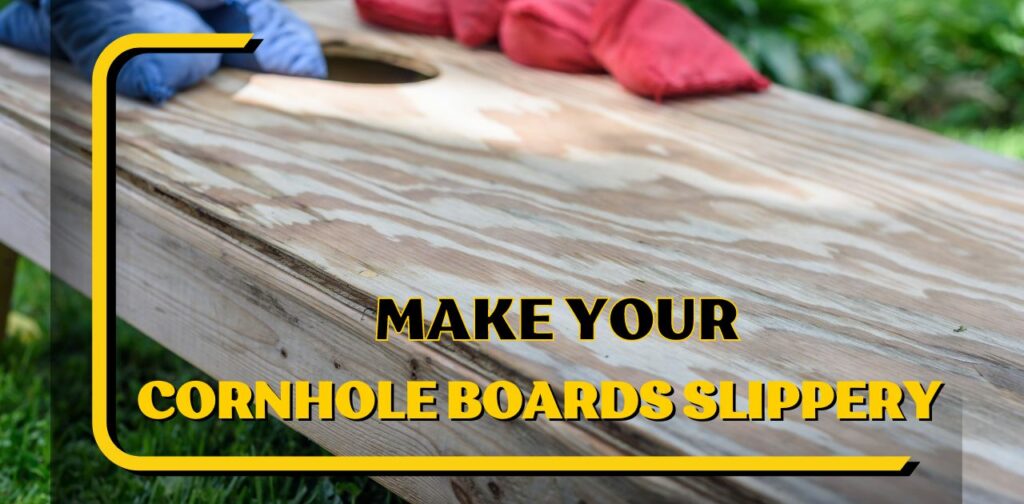How to Make Bean Bag Boards Slippery_ 10 Effective Ways
Bean bag toss, also known as cornhole, is a popular outdoor game that requires skill and precision. To excel in this game, it’s crucial to have the right equipment, including slippery bean bag boards. In this article, we will explore how to make bean bag boards slippery, why it’s essential, and how often you should maintain them for optimal performance.
Why Make Bean Bag Boards Slippery?
Before delving into the specifics of making bean bag boards slippery, let’s understand why it’s essential. The slipperiness of the boards directly affects the gameplay, making it more enjoyable and competitive. Here are a few reasons why slippery boards are crucial:
Consistent Gameplay: Slippery boards ensure that each throw is predictable and consistent. This fairness enhances the overall gaming experience and allows players to focus on their skills.
Skill Enhancement: When the boards have the right level of slipperiness, players can showcase their skill in throwing the bean bags accurately. The board’s surface plays a significant role in the trajectory and landing of the bags. Learn to Make your own cornhole bean bags.
Reduced Bounce: Slippery boards tend to minimize the bounce of the bean bags, making it easier to aim and score points. This reduces the element of chance and rewards skillful throws.
Now that we understand the importance of slippery bean bag boards let’s explore how to achieve that ideal level of slipperiness.
How to Make Bean Bag Boards Slippery
Creating the perfect level of slipperiness for your bean bag boards involves a few simple steps:

Clean the Surface
Start by cleaning the boards thoroughly. Remove any dirt, dust, or residue that may have accumulated over time. A clean surface is essential for the proper application of the slippery solution.
Choose the Right Lubricant
There are various lubricants available in the market specifically designed for bean bag boards. Look for a high-quality board wax or silicone spray. These products are designed to provide the right level of slip without causing damage to the boards.
Apply the Lubricant
Apply the chosen lubricant evenly to the surface of the boards. Use a soft cloth or sponge to spread the lubricant, ensuring complete coverage. Be cautious not to use too much, as excess lubricant can make the boards overly slippery.
Spread Evenly
After applying the lubricant, use a clean cloth to spread it evenly across the surface. This will help in achieving a consistent slipperiness level across the entire board.
Test and Adjust
Before your next game, test the boards to ensure they have the desired slipperiness. If they are too slippery or not slippery enough, adjust the amount of lubricant accordingly. It may take some trial and error to find the perfect balance.
Some Effective Ways on How to Make Bean Bag Boards Slippery
When it comes to playing a game of cornhole on a warm summer day, having slippery bean bag boards can make all the difference in your throwing accuracy. A smooth playing surface allows the bean bags to slide effortlessly, increasing your chances of landing that perfect shot. In this article, we will explore some effective methods to make your bean bag boards as slippery as possible.
Cleaning the Board
The first step in achieving a slippery surface for your bean bag boards is to ensure they are clean and free of any debris. Over time, dirt, dust, and other particles can accumulate on the surface, making it less smooth and causing the bean bags to drag.
To clean the board effectively, start by removing any loose dirt and debris using a brush or a handheld vacuum cleaner. Once the loose particles are gone, dampen a cloth with a mixture of mild soap and water. Gently wipe down the surface, paying special attention to any stubborn stains. Rinse the board thoroughly with clean water and allow it to dry completely before proceeding to the next step.
Also Read: How far are cornhole boards apart
Sealing the Board
After cleaning, it’s essential to seal the bean bag board to protect it from moisture and wear. A sealant helps maintain a smooth surface and prevents the wood from absorbing moisture, which can make the board less slippery.
Select a high-quality wood sealant, such as polyurethane, and apply it evenly to the entire surface of the board using a paintbrush or roller. Follow the manufacturer’s instructions for drying times and the number of coats required. Typically, two to three coats of sealant will provide adequate protection and enhance the board’s durability.
Applying Sandpaper
For those seeking a DIY solution to increase slipperiness, sandpaper can be a valuable tool. Sandpaper with a fine grit (around 220-320) is suitable for this purpose. Lightly sand the surface of the bean bag board in the direction of the wood grain. This process helps to create micro-grooves on the board’s surface, reducing friction when the bean bags slide.
Be cautious not to over-sand, as this can lead to an overly rough surface. Sand just enough to enhance slipperiness without compromising the board’s integrity.
Applying Tape
Another option to make your bean bag boards slippery is to use specialized cornhole tape. This tape is designed with a slick surface that reduces friction and helps the bean bags glide smoothly.
Apply the cornhole tape to the playing surface of the board, ensuring it adheres securely. Make sure there are no wrinkles or bubbles in the tape, as they can affect the game’s performance. Cornhole tape is available in various designs and colors, allowing you to customize your bean bag boards while improving their slipperiness.
Adding Wax
Waxing your bean bag boards is a traditional method to achieve a smooth playing surface. You can use a high-quality furniture wax or a specific cornhole board wax. Apply a thin, even layer of wax to the board’s surface and use a clean, dry cloth to buff it to a shine.
Waxing not only enhances slipperiness but also provides protection against moisture and wear. Regularly reapply wax to maintain the board’s performance.
Using PTFE Spray
PTFE (Polytetrafluoroethylene) spray is a high-performance lubricant known for its low friction properties. It can be an effective solution to make your bean bag boards exceptionally slippery. Spray a light, even coat of PTFE on the playing surface of the board, allowing it to dry thoroughly before playing.
PTFE spray is long-lasting and provides a consistent level of slipperiness. However, be cautious not to overapply, as excessive use can make the boards too slippery and challenging to control during gameplay.
Using Baby Powder
Baby powder is not just for infants; it can also work wonders on your bean bag boards. The fine powder is excellent for reducing friction and creating a slick surface. Here’s how to do it:
Begin by cleaning your bean bag boards thoroughly to remove any dirt or debris. A clean surface is essential for optimal results. Next, sprinkle a generous amount of baby powder evenly across the surface of the board. Make sure to cover the entire playing area.
Using a clean, dry cloth or a paintbrush, spread the baby powder evenly, ensuring it reaches all corners and edges of the board. This will help to create a uniform, slippery surface.After applying the baby powder, give it a test run by tossing a few bean bags. You’ll notice the difference immediately, with the bags gliding smoothly on the treated surface.
Applying Liquid Soap
Liquid soap is another household item that can come to your rescue when you need to make your bean bag boards slipperier. Follow these steps to apply liquid soap effectively:
Clean your bean bag boards thoroughly to remove any dirt, dust, or grime that may be present on the surface. Mix a small amount of liquid soap with water in a spray bottle. A ratio of approximately one part soap to three parts water works well.
Spray the soapy mixture evenly onto the surface of the bean bag boards, ensuring full coverage. Use a clean cloth or sponge to spread the soapy solution, creating a thin, even layer on the board’s surface. Allow the boards to air dry or wipe them with a dry cloth. Once dry, you’ll have a slick playing surface ready for some cornhole action.
Using Vegetable Oil
Vegetable oil is a kitchen staple that can also be used to make your bean bag boards extra slippery. Here’s how to go about it:
Start by cleaning your bean bag boards thoroughly to ensure they are free from any dirt, grease, or debris. Pour a small amount of vegetable oil onto a clean, dry cloth or paper towel. Gently rub the vegetable oil onto the surface of the boards, making sure to cover the entire playing area evenly. Allow the oil to penetrate the wood for a few minutes, then wipe off any excess oil with a dry cloth. Your boards are now coated with a thin layer of vegetable oil, providing a slick surface that will help your bean bags slide with ease.
Applying Talcum Powder
Talcum powder, known for its smooth and silky texture, can be an excellent choice for making your bean bag boards slippery. Here’s how to apply it effectively:
Begin by cleaning your bean bag boards to remove any dirt or dust that may have accumulated. Sprinkle a liberal amount of talcum powder evenly across the playing surface of the boards. Using a clean cloth or a paintbrush, spread the talcum powder evenly, ensuring it reaches all corners and edges of the boards. After application, test the boards with a few bean bag tosses to ensure they are suitably slippery for your game.
How Often Should You Make Bean Bag Boards Slippery?
The frequency of making your bean bag boards slippery depends on various factors, including how often you play and the weather conditions. Here are some guidelines:
Regular Maintenance: If you play cornhole frequently, it’s a good practice to check the slipperiness of the boards before each game. This ensures that the boards are in optimal condition for competitive play.
Weather Considerations: Humidity and temperature can affect the slipperiness of the boards. In humid conditions, boards may become stickier, requiring more frequent lubrication. In dry conditions, you may need to apply lubricant less often.
Seasonal Maintenance: Consider doing a thorough maintenance of your bean bag boards at the start of each cornhole season. This involves cleaning, reapplying lubricant, and ensuring they are in top condition for the upcoming games.
Wrapping Up
Making your bean bag boards slippery is a simple yet essential aspect of enjoying the game of cornhole to the fullest. By understanding the importance of slipperiness, following the right steps to achieve it, and maintaining your boards regularly, you can enhance your gameplay and make each throw count. So, grab your bean bags, prepare your boards, and get ready for some competitive and exciting cornhole matches!






